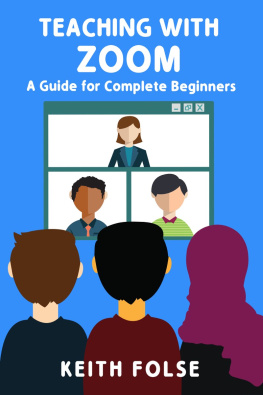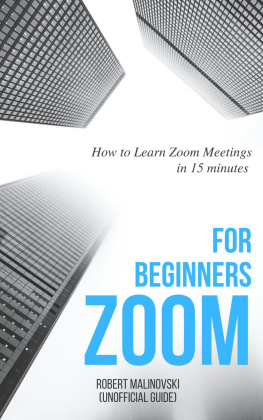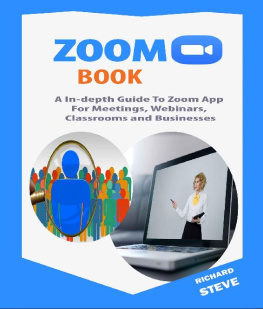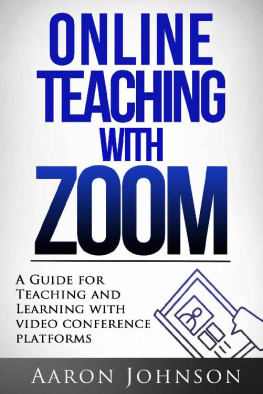Keith Folse - Teaching with Zoom
Here you can read online Keith Folse - Teaching with Zoom full text of the book (entire story) in english for free. Download pdf and epub, get meaning, cover and reviews about this ebook. publisher: Wayzgoose Press, genre: Religion. Description of the work, (preface) as well as reviews are available. Best literature library LitArk.com created for fans of good reading and offers a wide selection of genres:
Romance novel
Science fiction
Adventure
Detective
Science
History
Home and family
Prose
Art
Politics
Computer
Non-fiction
Religion
Business
Children
Humor
Choose a favorite category and find really read worthwhile books. Enjoy immersion in the world of imagination, feel the emotions of the characters or learn something new for yourself, make an fascinating discovery.
- Book:Teaching with Zoom
- Author:
- Publisher:Wayzgoose Press
- Genre:
- Rating:4 / 5
- Favourites:Add to favourites
- Your mark:
- 80
- 1
- 2
- 3
- 4
- 5
Teaching with Zoom: summary, description and annotation
We offer to read an annotation, description, summary or preface (depends on what the author of the book "Teaching with Zoom" wrote himself). If you haven't found the necessary information about the book — write in the comments, we will try to find it.
Teaching with Zoom — read online for free the complete book (whole text) full work
Below is the text of the book, divided by pages. System saving the place of the last page read, allows you to conveniently read the book "Teaching with Zoom" online for free, without having to search again every time where you left off. Put a bookmark, and you can go to the page where you finished reading at any time.
Font size:
Interval:
Bookmark:
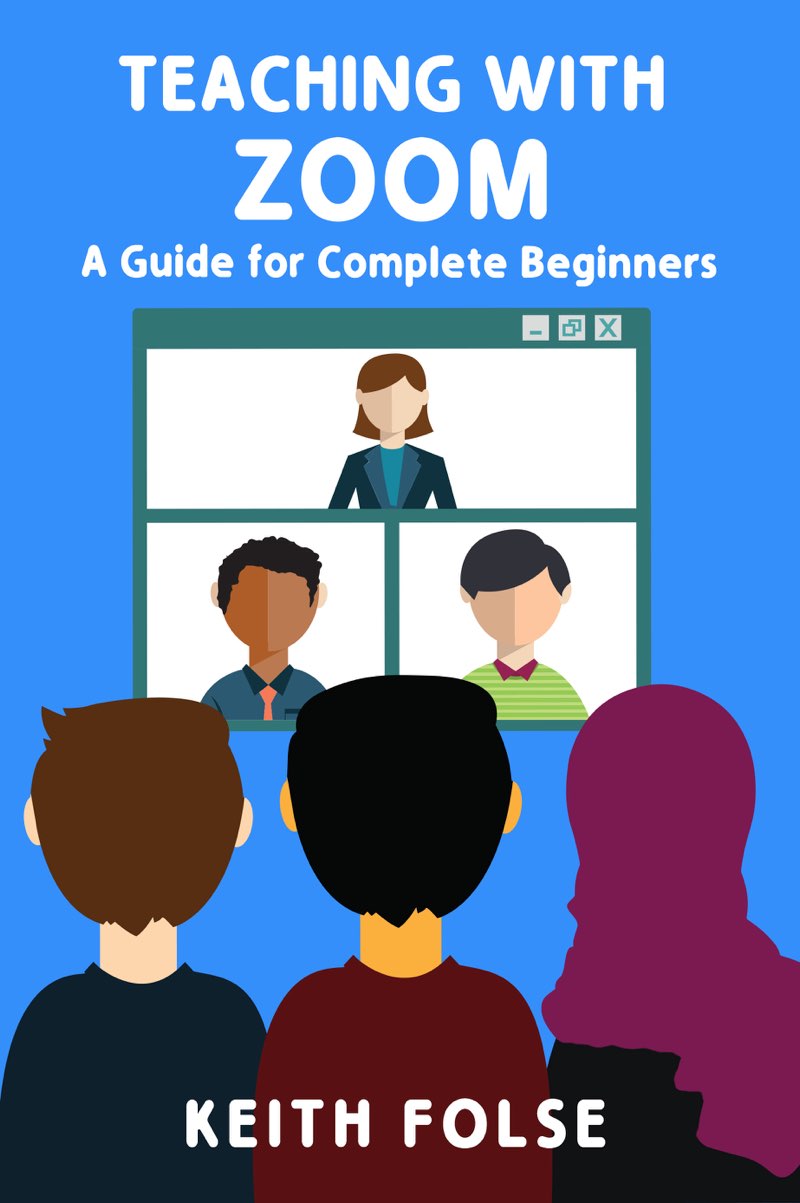

Copyright 2020 by Wayzgoose Press
All rights reserved.
No part of this book may be reproduced in any form or by any electronic or mechanical means, including information storage and retrieval systems, without written permission from the author, except for the use of brief quotations in a book review.
Legal Disclaimer: The author has attempted to make sure that the information in this book is accurate. However, neither the author nor the publisher is responsible for errors or discrepancies. Technology has constant changes, such as with periodic updates or security enhancements, and these may in turn modify or even nullify information that has been presented here. In addition, some information may differ depending on the type of Zoom plan that you are using or the type of device with which you are accessing Zoom.
The purpose of this book is to help teachers. Your results may differ from the authors for a variety of reasons. The author is not responsible for any poor results you may obtain by following information, suggestions, or ideas in this book.
All company names and websites mentioned in this book are trademarks or copyrights of their respective owners. The author is not affiliated with them in any way and does not endorse them or their ideas.
Note: The student names that appear in the screenshots of this book have all been anonymized. Permission was secured for any photos shown.
I.
II.
III.
IV.
V.
VI.
VII.
VIII.
IX.
Like thousands of other teachers in early 2020, I suddenly had to move my class to a synchronous (live) online meeting without a lot of time or support to do so. I am a teacher, so I managed. In my case, this meant trying to figure out how to do all of my regular class interactions like explaining new material, answering student questions, and getting students to work in pairs or small groups in this new live online setting using Zoom.
I needed to know how to use Zoom really well and really fast, so I did what anyone would do today: I googled Zoom for relevant information. Yes, I was able to find some information and even training videos about Zoom on the internet, but I found very little about teachers and classrooms. Zoom was originally designed for business, not education. Not surprisingly, very little really spoke to me as a teacher. (Update: Now there are many more teacher-focused explanations, most of which were made in March and April 2020.)
I signed up for many online presentations about Zoom. I remember one training webinar from Zoom that said Here is how you can create a meeting room with different options, but wait What is a meeting room and why would I as a teacher want those options? It seemed to me that most of these presentations assumed I knew certain things about Zoom, which was definitely not the case.
I didnt want just the generic instructions of how to do something; instead, I wanted to know specifically about the things that teachers need. Ideally, I really wanted to hear this information from a real teacher talking about a real classroom experience with real students.
I am pretty good with computers, but I am not a computer expert at all. The information I am providing here is coming from my teacher voice as I try to help other teachers. The only assumption I make about readers here is that you are a teacher, you have a computer and at least basic computer skills, and you can search for a website if needed.
In reality, how much you can and will use Zoom (and other forms of technology) in your own classes depends on who you are as a teacher, what you teach, who you teach, and why you want to use Zoom. Thats a lot of variables. To understand how Ive organized this book, you should know something about my teaching background, which certainly impacts how I use Zoom in my own classes today.
I was originally secondary certified (grades 7-12) in English Language Arts, but I am now a professor at a very large US university, where I have taught undergraduate, graduate, and doctoral courses for many years. I have also taught children as young as 2nd grade and adults up to their 70s. In all my years of teaching, I have taught mostly English as a second language (ESL) or French and Spanish, and I now train future language teachers.
Probably like you, most of my teaching has been in traditional face-to-face classes, but for the last 15 years, I have done more and more asynchronous classes at my university, which means courses that meet completely online with assignments due within weekly modules. I still teach regular face-to-face courses, but even my current Zoom classes have a great deal of asynchronous work before class so that we can spend class time doing, practicing, and applying (which is what we call a flipped classroom).
With the arrival of COVID-19, my school, along with hundreds of others, closed suddenly, and all classes were moved online. Some professors opted to have only asynchronous courses, and I certainly could have easily done the same. However, I already had such good personal rapport with so many of my students this term that I didnt want to move the remaining weeks of instruction to the faceless and often impersonal instruction sometimes found in asynchronous modules. Because I had worked a little with Zoom before and because my university suddenly added Zoom to the free items in our course management system (Canvas), I opted to use Zoom.
I am not a tech person. I dont know all the ins and outs of Zoom, but I am a teacher who had to figure out how to use Zoom effectively in my courses. Im not saying I have the best ways to use all of the Zoom features, but I will tell you about some ways that I have found easy to implement and have actually used in my own classes. If youre like me, you dont want to spend a lot of your already severely limited time learning a new program unless it appears to be worth it. I should also add here that I fully realize that Zoom, like most forms of tech, will continue to change, and some of the information in this book may differ from your version of Zoom in the plan that you have.
Teaching a class with Zoom can be a great experience if you can master a few of Zooms practical features. To this end, Ive written this book to help my fellow teachers who are also trying to figure out how to teach their classes well with Zoom. Good luck, everyone!
The organization of the material in this book is quite simple. A foreword explains the rationale for writing this book and how it can benefit you in your classes.
The material is divided into nine parts that address the most important information for teachers. There is information on what to do before you teach with Zoom, when you teach with Zoom, and after you teach with Zoom. Assessment as well as security and privacy issues are also addressed. One of the most interesting and important parts is Part 7, which includes dozens of comments from students, parents, and teachers with experience with Zoom. There are also sections for troubleshooting common problems and getting additional help from all types of sources.
Font size:
Interval:
Bookmark:
Similar books «Teaching with Zoom»
Look at similar books to Teaching with Zoom. We have selected literature similar in name and meaning in the hope of providing readers with more options to find new, interesting, not yet read works.
Discussion, reviews of the book Teaching with Zoom and just readers' own opinions. Leave your comments, write what you think about the work, its meaning or the main characters. Specify what exactly you liked and what you didn't like, and why you think so.

